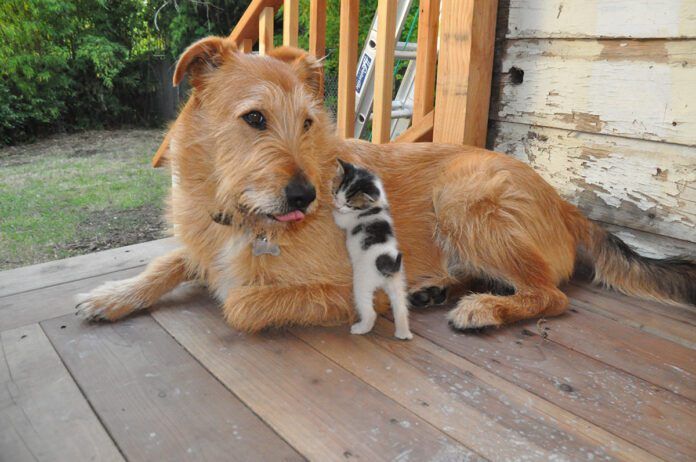
Here’s a memory that just came up: A blog post from July 2011 – 12 years ago!
I’ve been having a nice dialogue with a reader who objected to my promotion of the word “cue” over “command.” He made some good points – but something Otto did the other day gave me ammunition for one more point in support of why I prefer “cue.”
Copying their mama, the last two of my foster kittens (now MY kittens) have developed a classic behavioral response to Otto (and every dog, to be fair to kind, patient Otto): they puff up, spit, growl, and flatten their ears every time they notice him in the room. Frankly, they are often so occupied with play that sometimes this “noticing” happens when they actually run into his sleeping body, but whatever. I keep praising and rewarding Otto for his calm, gentle behavior around them, and for turning instantly away from them any time he starts looking too interested in joining their chasing games.
The other day, as a reward, I initiated a game with Otto and his current favorite toy: bunny-shaped stuffed animal with a squeaker inside. (It’s from Premier Pet Products, and it’s ingenious; the belly of the bunny contains a rubber cage that enables the squeaker to roll about, making its position unpredictable. Otto LOVES mouthing the bunny in search of the ever-elusive squeaker.) I said, “Where’s your toy?” This is the cue I use to ask Otto to go get a toy. Otto looked thoughtful about this for a moment (as he often does), and then I saw the light bulb go on (as it almost always does) and his expression brightened before he bounded out of my office to go find the bunny. I could see it; it was in the middle of the living room floor. But just as he arrived at the toy, one of the kittens launched from out from under the couch, right onto the bunny (the kittens like it, too).
Okay, a dilemma. Otto was asked to do something; he also knows he’s not supposed to chase or harm the kittens. If he “obeyed” my “command” to get the toy, he’d surely get in trouble for being confrontational with the kitten. He had to use some judgment – and I want to develop and nurture that judgment. In the real world, I really don’t want a robot, who follows orders no matter what.
I can only imagine that service dogs are trained similarly. They must do what their owners ask, but sometimes, their owners ask them to do something they know is dangerous, like walk in front of a car that their blind and deaf owner doesn’t know is coming too fast. They have to understand that in some cases, a refusal is the right thing to do. In this case, the word “cue” really is more appropriate than “command.” I’d love to hear from service dog trainers about how they cultivate this trait, without creating a dog who “refuses” when it suits his needs, rather than his handler’s.
In this case, I’m proud that Otto knew to “disobey” me. He quickly stepped back from the spitting kitten, and looked at me, tail wagging, for further instructions. “Yes!” I applauded him, jumping up from my chair and skipping into the kitchen to get him something extra yummy from the fridge. “Good dog!” And when the coast was clear of kittens, he got another reward. “Otto! Where’s your toy?”





Our family is raising a Seeing Eye puppy that will go into formal training in about a month. The Seeing Eye breeds their own pups and has a large group of volunteer puppy raisers that teach the pups to be good canine citizens. We teach basic commands, sit, down, come, rest, and expose them to lots of real world situations such as going to work, shopping, traveling by car, train or bus. But the formal training is done by the professionals when they return to The Seeing Eye. The concept described in this article is exactly what they teach there, “Intelligent Disobedience”. It is incredible to watch the dogs with their trainers when they are out and about in my city, learning the difficult tasks of guiding a person that is sight impaired. I can’t tell you how they do it, I just know it is a very challenging task. For those pups that fail, they are incredible at other things such as Search and Rescue, bomb detection, etc, also challenging tasks, but none as difficult as a Seeing Eye Dog.
This is a great example of the difference between a dictator (commands) and a great leader (cue). The difference in relationships is huge.
Could you provide more information on the toy that Otto is playing with? I haven’t been able to locate it on the internet. This sounds like something my rescue would just love!
I would also like info re this toy – sounds great!
I’m also interested in this toy but cannot find it on the internet.
Wow, can’t believe Otto has such restraint at his age!!! SO happy to hear he’s still with you. I still miss my Sammy boy that I lost last June. Can’t complain though, he was almost 17 years old!
I find there to be huge difference in the word cue vs. command. I want my dog to have the choice to make the correct decision when I’m asking for a cue. I do not to command him against his will. For the folks asking about the toy, it is called a pogo plush by petsafe. I think they are now discontinued by the manufacture but I was able to pull up several stores that have stock via the internet.